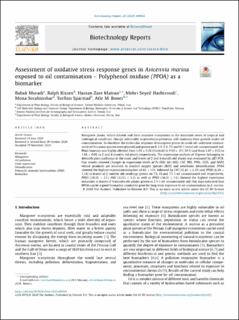| dc.contributor.author | Moradi, Babak | |
| dc.contributor.author | Kissen, Ralph | |
| dc.contributor.author | Maivan, Hassan Zare | |
| dc.contributor.author | Hashtroudi, Mehri Seyed | |
| dc.contributor.author | Sorahinobar, Mona | |
| dc.contributor.author | Sparstad, Torfinn | |
| dc.contributor.author | Bones, Atle M. | |
| dc.date.accessioned | 2020-12-17T10:58:29Z | |
| dc.date.available | 2020-12-17T10:58:29Z | |
| dc.date.created | 2020-11-30T14:58:28Z | |
| dc.date.issued | 2020 | |
| dc.identifier.citation | Biotechnology Reports. 2020, 28, . | en_US |
| dc.identifier.issn | 2215-017X | |
| dc.identifier.uri | https://hdl.handle.net/11250/2719997 | |
| dc.description.abstract | Mangrove plants, which inhabit and form sensitive ecosystems in the intertidal zones of tropical and subtropical coastlines, though vulnerable to petroleum pollution, still maintain their growth under oil contamination. To elucidate the molecular response of mangrove plants to crude oil–sediment mixture, seeds of Avicennia marina were planted and grown on 0, 2.5, 5.0, 7.5 and10 % (w/w) oil-contaminated soil. Plant biomass was highly affected from 3.05 ± 0.28 (Control) to 0.50 ± .07 (10 %) and from 3.47 ± 0.12 to 1.88 ± 0.08 in 2 and 4 months old plants respectively. The expression analysis of 11genes belonging to detoxification pathways in the roots and leaves of 2 and 4 month-old plants was evaluated by qRT-PCR. Our results showed changes in expression levels of Fe-SOD, Mn-SOD, CAT, PRX, PPOs, GSTs, and NAP2 whose products are involved in reactive oxygen species (ROS) and xenobiotic detoxification. PPOA showed the highest expression induction of 43 ± 1.15, followed by CAT (12.61 ± 3.25) and PPOB (6.38 ± 1.34) in leaves of 2 months old seedlings grown on 7.5, 10 and 7.5 % oil contaminated soil respectively. PPOA (39.23 ± 2.1), PRX (32.13 ± 1.2) as well as PPOB (26.11 ± 1.3) showed the highest expression induction in leaves of 4 months old plants grown in 2.5 % oil contaminated soil. Our data indicated that PPOA can be a good biomarker candidate gene for long term exposure to oil contamination in A. marina. | en_US |
| dc.language.iso | eng | en_US |
| dc.publisher | Elsevier | en_US |
| dc.relation.uri | https://doi.org/10.1016/j.btre.2020.e00565 | |
| dc.rights | Navngivelse 4.0 Internasjonal | * |
| dc.rights.uri | http://creativecommons.org/licenses/by/4.0/deed.no | * |
| dc.title | Assessment of oxidative stress response genes in Avicennia marina exposed to oil contamination - Polyphenol oxidase (PPOA) as biomarker | en_US |
| dc.type | Peer reviewed | en_US |
| dc.type | Journal article | en_US |
| dc.description.version | publishedVersion | en_US |
| dc.source.volume | 28 | en_US |
| dc.source.journal | Biotechnology Reports | en_US |
| dc.identifier.doi | https://doi.org/10.1016/j.btre.2020.e00565 | |
| dc.identifier.cristin | 1854282 | |
| dc.description.localcode | This is an open access article distributed under the terms of the Creative Commons CC-BY license, which permits unrestricted use, distribution, and reproduction in any medium, provided the original work is properly cited. | en_US |
| cristin.ispublished | true | |
| cristin.fulltext | original | |
| cristin.qualitycode | 1 | |

